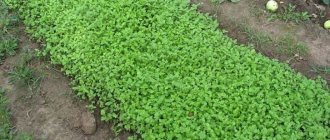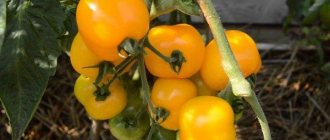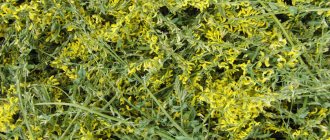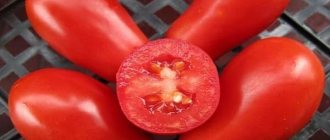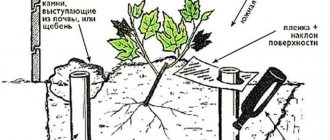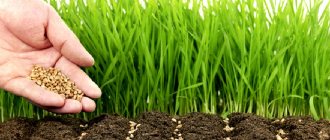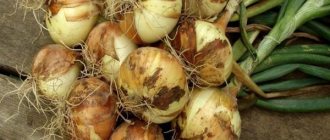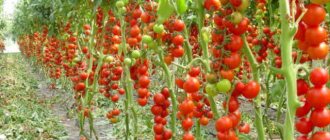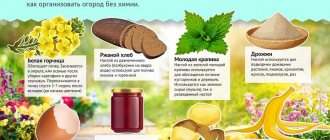What are green manure plants used for?
When gardeners plant tomatoes, they expect a good harvest. But collecting it is not so easy; the reason for this is specific factors that can affect the fruitfulness of the crop.
You can use various fertilizers, buy preparations and water the tomatoes with them, but it is easier to use green manure because they:
- Allows you to increase crop productivity.
- Reduce the risk of tomatoes being damaged by various diseases and pests.
- Reduce the number of weeds from which the planting will have to be protected.
Green manures are plants that can significantly affect the qualitative and quantitative indicators of the harvest. They act as a natural fertilizer.
During the process of growth and development, plants saturate the soil with nitrogen, and also increase the effectiveness of the preparations used if the gardener decides to fertilize the tomatoes.
There are several crops that agronomists recommend using for growing tomatoes. Plants have their own characteristics.
Mistakes gardeners make when using green manure
So, the season is ending, there is still a little time left and autumn will begin, and then winter. Gardeners are beginning to sum up the results and for many, unfortunately, they are not comforting. It’s especially offensive to those who see that things are completely different on their neighbor’s plot, the harvest is good, the trees are healthy. Let’s start with mistakes when fertilizing. This is perhaps the most common type of gardening mistake. Usually, trying to make everything grow faster on the site, we feed the plants without measure; what’s also scary is that we feed them with nitrogen fertilizers, because they accelerate growth.
Which can delay the growing season for a week or even more.
Little moisture when watering. This is perhaps the most common mistake.
Errors associated with pruning occur due to inept handling of cutting tools. The most common consequences of improper pruning are the formation of a large number of tops and gum formation or crying.
You should firmly understand that you cannot prune your garden in the fall and in frosty weather; cuts, especially large ones, can get wet and freeze. Pruning should be done at the end of February or beginning of March. As for stone fruit crops, there is no need to trim them at all; you can only shape them using the bending method, as carefully as possible, in order to prevent injury. Another common mistake is scattering green manure all over the place. Yes, green manure crops are useful, there is no doubt, however, if they are sown in areas deprived of watering, tree trunks and bush strips, and even if green manure crops are not mowed for a long time or are not mowed at all, then this will do much more harm than good.
Green manure can be beneficial if it is sown in the second half of the warm season, when plants require less nutrients and moisture due to reduced growth activity.
Mulching cold soil. Remember once and for all - you cannot mulch the soil in early spring! If straw is used as mulch, it will reflect sunlight, and the soil will take longer to warm up under the straw.
Tops appear, often in large numbers, as a result of excessively strong pruning, because the balance between the roots and the above-ground parts of the plants is disturbed. They should be pinched or bent, and all excess should be removed.
Shortening the conductors can help reduce the growth of vertical shoots; this can be done in the summer.
Overgrowth, you can’t run it. It is formed as a result of the gardener mindlessly digging up tree trunk circles. The growth appears as if from nowhere, and its intensity is sometimes surprising. Dealing with shoots is quite difficult, for example, in a mountain ash you have to dig to the root, look for the place where the shoots come from, cut off part of the root, cover it with garden varnish and fill it up.
Types of crops and their properties
When deciding which green manure crops are best to sow, it is worth familiarizing yourself with their features and differences. Most often, preference is given to one crop, but you can use several plants - this will significantly increase the yield. However, the choice remains with the gardener, and it depends on the planting conditions and the characteristics of the tomato variety.
Cruciferous
This is, first of all, a Pancake Day radish; it has good characteristics: it germinates quickly, develops a branched root system, grows in any climatic conditions and is not picky about the soil. Due to its characteristics, green fertilizer not only saturates the soil with azine, but also reduces the likelihood of nematodes (worms) appearing in it.
Cereals
We are talking about different cultures; The following plants can be included in this group:
- vetch;
- rye;
- oats
If we talk about oats, they are more useful because they enrich the soil with potassium. As for rye, it dries out the soil and absorbs excess moisture, for this reason it is better to plant it in the ground or greenhouse, which has high humidity. Vetch is considered universal; gardeners turn to its help most often, but do not forget about the benefits of other crops.
Legumes
They are often used and combined with other plants. Such a “tandem” can significantly influence the yield of tomatoes.
Legumes include:
- Soy.
- Lentils.
- Clover.
See also
Description of the best varieties of tomatoes for greenhouses in the Kirov region
Read
They have good germination, are frost-resistant and saturate the soil with oxygen. If you decide to use clover as green manure, remember that this crop is not suitable for acidic soils. Otherwise, legumes create abundant green cover, which can be considered their advantage.
Why is green manure needed?
Green manure performs several functions at once, influencing the composition of the soil layer, protecting plantings from pests, and attracting beneficial insects to the site during the flowering period. When choosing green manure for tomatoes, use plants from the cereal, legume, and cruciferous families, excluding nightshade crops related to tomatoes.
The grown green shoots are dug up. The effectiveness of plowing green fertilizers on the standing soil is comparable to the use of manure. In some cases, the green flooring is mowed, used as mulch or for making compost.
Using the characteristics of various groups of plants, they naturally improve the physical and chemical properties of the soil:
- incorporating green mass into the soil increases the organic content and significantly accelerates the process of humus formation;
- increased microbial activity contributes to the creation of beneficial microflora, which gives the plant the opportunity to receive nutrients in an accessible form;
- the short growth period and powerful root system of some green manures contribute to effective weed control. They shade the top layer of soil and inhibit the germination of weeds;
- green manure roots loosen the soil, improve its aeration and moisture capacity;
- Some plants are able to reduce soil acidity and resist fungal infections and pests.
Depending on the characteristics and degree of soil depletion, plants are selected for green manure. These crops are not demanding to grow, but when watered they gain green mass faster.
Differences for open ground and greenhouses
In general, there are no special differences, since green manure can be used in any conditions: they are equally suitable for greenhouses and open ground. But gardeners have their own “preferences”.
In open ground, you can plant any crops without thinking about the nuances of planting. For a greenhouse it is better to use:
- rye;
- vetch;
- mustard;
- bush beans.
Attention! Green manure is planted in a greenhouse in the spring, after the harvest. Then they mow before planting tomatoes - during this time the plants saturate the soil with useful substances.
What crops to grow for tomatoes as green manure?
The use of many crops can have a positive effect on vegetable plants, but the greatest effect will be obtained from:
- White mustard - it repels pests from the garden plot, fills the soil with phosphorus and sulfur, and does not allow weeds to grow.
- Vetch is an excellent green manure that acts as a source of nitrogen. When used, tomato yields increase up to 40%.
- It is recommended to grow phacelia in acidic soils; it prevents the appearance of various fungal diseases and fills the soil with the most essential micronutrients.
- Alfalfa – This green manure from the legume family increases the nitrogen content in the soil, which affects the growth of tomatoes.
- Lupine allows you to fill the soil with oxygen by making it loose. Indispensable for pest control on the site.
In addition, rye, oats, and buckwheat enrich the soil well.
We calculate sowing density and material consumption
Green fertilizers are planted between the beds, the consumption directly depends on the type of crop. Let's consider several options and calculate the average material consumption:
| Mustard | The average consumption is 200-300 grams per hundred square meters. Approximately 2-3 grams of seeds will be needed per square meter. |
| Red clover | It has large seeds, consumption per hundred square meters is 160-200 grams, about 2 grams per 1 square meter. |
| Oats | If you decide to take this crop, then you will need a little more than 150 grams of seeds per hundred square meters. Per 1 square meter - from 15 to 20 grams. |
How to sow green manure when and where
If the seeds are small and light, and the soil is light, the material should be deepened well. Otherwise, the soil does not require preparation. Many green manures can be sown even on mowed grass. It is enough to walk over it with a pitchfork and moisten it, having finished planting green fertilizers.
When to sow green manure depends on the selected species and the tasks facing it. There are 4 options:
Autumn sowing for winter crops. Takes place from September 1st to the first half of November. This is due to the difference in climate in the regions of Russia.
In the spring, 2 weeks before planting fruit crops, green manure is cut and placed in the ground. A break is needed for the poisons released by the roots of rye, oats and other green fertilizers to decompose. Another 2 weeks are spent feeding worms and beneficial microorganisms with green manure, enriching the soil with nitrogen, mineral components, and vitamins.
Autumn sowing for ordinary varieties. They are planted with the onset of frost to avoid autumn seedlings. Due to planting before winter, green manure grows faster in spring. The method is recommended for soybeans, rapeseed, vetch, rapeseed, oats, and mustard. Cyclic sowing of green fertilizers. The first planting takes place in early spring. Green manure with a short growing season is selected. Then the land is occupied by early fruit crops. After harvesting, their plot is again sown with green manure and so on. Sowing perennial green fertilizers. These are placed on the ground for a minimum of 2 years and a maximum of 5 years. Plowing is done a season before planting fruit and vegetable crops
Next, when working with green manure, it is important to cut off the flower stalks in time. Otherwise, green fertilizer will turn into an uncontrollable weed.
The landing pattern is as follows. The planting area is determined and the required number of seeds is calculated. They are divided equally. They go over the treated area with a rake. The weeds are removed. You can sow the first half of the material. The second part of the seeds is distributed perpendicular to it. If the seeds are large, sow green manure in the furrows left by flat cutters and hoes.
When to seed
As a rule, this is done during the off-season. Before you start sowing green manure, make sure the soil is ready for such procedures.
in spring
Planting is carried out before planting tomatoes; the time is calculated so that the crop has time to sprout and grow. When greenery appears on the surface of the soil, it must be mowed before the flowering period, otherwise all efforts will be wasted.
in autumn
In autumn, planting is carried out after harvesting. “Under the snow,” as they say. Over the winter, the plants “nourish” the soil with useful substances. You will have to mow them before planting tomatoes.
Determining the required variety
As has been proven by many gardeners, it makes no sense to choose one type of green manure for tomatoes. Special selection and different crops in the total mass give the same results. But a mixture of different types can increase performance many times over.
Main functions of green manure:
- reduction of growth activity of parasitic microorganisms;
- increasing the concentration of minerals on the surface;
- increasing the enrichment of the root system and fruits of the plant with minerals;
- allows you to avoid the mandatory replacement and renewal of soil;
- increases the amount of nitrogen in the upper layers of the soil;
- increases the physical readings of the soil.
In order to determine the optimal combination, you can use the recipes of friends and acquaintances. Based on the results, the proportions should be varied.
Plan for sowing and caring for green manure
As mentioned earlier, planting of green manure is carried out at different time periods. This allows you to significantly increase the tomato yield. Let's consider the characteristics of crops and determine the appropriate time for them.
Vika
Can be planted in the soil three weeks before the planned planting of tomatoes. It is considered one of the best options, as it increases tomato yields by an average of 30%.
Radish
A crop that tolerates frost well, it can be planted at the end of summer, or better yet, in autumn.
White mustard
It has good frost resistance, so after harvesting it can be planted in the ground. It saturates the earth with useful elements: sulfur and phosphorus.
Phacelia
Suitable for reducing soil acidity, it can be planted in spring. Phacelia significantly increases the level of potassium, nitrogen, and also prevents the appearance of weeds.
Alfalfa
Due to its specificity, it improves the quality indicator of the soil; it can be planted in early spring or closer to summer, in May.
Lupine
The plant is effective against pests and loosens the soil. Lupine can be planted in a greenhouse, but better in the ground, in mid-spring.
See also
Causes and treatment of tomato Alternaria, combating dry spots on leaves
Read
Oats
It is good at any time of the year, tolerates cold calmly, germinates quickly and does not require additional care. Plant it in spring or autumn - there is no big difference, but if the climate in the region is harsh, then it is better in April or late March.
Oilseed radish
Planted in the spring, it is not recommended to plant it “under the snow”.
Peas
Differs in versatility. This crop tolerates frost well, but it is better to plant it in the spring, at the end of April.
Rye
Planted for the winter, late summer or early autumn. Under the snow, the crop “nourishes” the soil, it is frost-resistant and grows quickly. Before planting tomatoes, it is mowed.
Let's consider the scheme of actions, in accordance with the time of year, and analyze the actions of the gardener:
| Early autumn or late summer, after harvest: | We plant crops in the soil “for the winter.” |
| The beginning of spring: | Using a flat cutter, we loosen the plants that were left to overwinter in the ground. |
| In the middle of April: | We feed with various microelements. |
| In May: | We carry out additional sowing. |
| From the beginning of June to the end of summer, at least once every 2-3 weeks: At the end of August and mid-September: | We loosen the soil together with green manure. We carry out the next sowing of crops, with rotation, that is, if we previously planted rye, now we give preference to mustard or radish. |
The best green manure for potatoes
For potatoes, cold-resistant crops cope well with the task: peas, phacelia, oats, mustard.
Sowing of green manure is carried out in the spring, as soon as the ground thaws. For one hundred square meters you will need about 2 kg of seeds of the selected plant. By the time the potatoes are planted, they will have time to increase the required volume. Before flowering or two weeks before the planned planting of potatoes, “green fertilizers” are embedded in the soil.
After this, the potatoes are planted at a depth (50-60 mm), it is recommended to plant mustard between the rows; it will be useful in that it will loosen the soil and retain the necessary moisture in it, as well as repel unwanted pests and suppress the growth of weeds. When the bushes are equal in height, the mustard needs to be cut down.
Mow or dig up
In addition to mowing green manure, there is another method of planting them. The seeds are planted in the soil and then dug up. But this method is considered less effective for several reasons:
- The integrity of the soil cover is destroyed, resulting in the release of useful substances necessary for plants from the ground. This is considered a disadvantage of this technique.
- You can plant green manure in the ground or greenhouse together with tomatoes. But in this way they will not be able to bring maximum benefit to the crop, but they will perfectly “protect” it from weeds.
Sowing time
Very often, to sow green manure crops, vegetable growers wait until the main crop is completely harvested. However, in a greenhouse, tomatoes bear fruit until late autumn, and even with the onset of significant cold weather, quite heavy fruits still weigh on the branches.
Considering all the features of tomato production technology, sowing green manure in a greenhouse cannot be delayed until late autumn; it must be sown in August. During this period, the lower leaves have already been removed, mulch lies under the bushes, and underneath it is warm and humid. It is possible and necessary to sow the soil with green manure and get a huge effect from it.
Rake off the mulch, sow the green manure mixture and cover everything with the mulch you raked. Water and wait for shoots. The greenery that appears will begin to grow very quickly. Once it reaches a height of 25-30 cm, mow or cut it. Further growth will no longer be so lush, since the temperature background drops and the illumination decreases, but the green carpet will, although slowly, increase, becoming lush.
Planting period
Plants that will serve as green manure for tomatoes can be grown throughout the season. In spring, those crops that are not afraid of frost are grown. The best spring green manure is white mustard. After mowing it, the soil can be covered with organic material (straw, peat, bone meal). This will speed up the decomposition of mowed greens, which will improve the nutritional value of the soil.
In autumn, the most suitable green manure is rye. It is planted after harvesting and remains to overwinter in the soil. Rye is mowed in the spring, the day before planting tomatoes.
